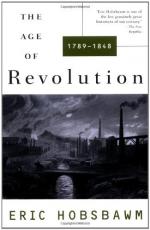
|
| Name: _________________________ | Period: ___________________ |
This test consists of 15 multiple choice questions and 5 short answer questions.
Multiple Choice Questions
1. How does Hobsbawm say conditions for the working poor changed in the mid-1800s?
(a) He says that they became more and more sanitary over time.
(b) He says that they deteriorated.
(c) He says that they were better regulated by the government.
(d) He says that they largely improved.
2. What tool did the upper classes use to discriminate against the working poor?
(a) Legislation.
(b) Anti-union gangs.
(c) Hiring decisions.
(d) Military repression.
3. Which religion was expanding from Turkey through Africa and to the east?
(a) Hinduism.
(b) Confucianism.
(c) Islam.
(d) Shinto.
4. In what way did conservative thinkers resist middle class ideology?
(a) By appealing to history and tradition.
(b) By studying ancient cultures.
(c) By advocating for international trade.
(d) By inciting revolutions to revert to ancient values.
5. What did the new view hold that was spreading through Europe?
(a) The improvability of the system by engineers and scientists.
(b) The spiritual unification of humanity in a global community.
(c) The value of tradition in ritual and mystery.
(d) The progress of society through reason and philosophical enlightenment.
6. How did Hobsbawm characterize the change in the way that people related to the land, and the way land was related to the economy?
(a) As the most catastrophic phenomenon of the period.
(b) As the least recognized phenomenon of the period.
(c) As the least forgivable development of the period.
(d) As the most lucrative development of the period.
7. How was Beethoven's Eroica connected to the politics of Beethoven's time, in Hobsbawm's account?
(a) It was dedicated to Napoleon.
(b) It contained cannons.
(c) Beethoven had been deafened by cannon fire before he wrote it.
(d) It glorified conquest.
8. What stage was the political theory in when the organizers were making promises to the workers in the mid-1800s?
(a) It was not well-organized enough to be a threat.
(b) It was still a lot of dreaming by people who were powerless to act.
(c) It was meeting the political will to begin to strive towards achieving its goals.
(d) It was establishing coalitions with policemen, soldiers, and union leaders to present demands and back them with force.
9. In Hobsbawm's account, what happened in France as industrialism expanded in neighboring countries?
(a) Land reforms from the French Revolution tied land use to the peasantry, and the economy did not take off.
(b) The economy was paralyzed by the veterans returning from the wars to the small plots of land Napoleon had promised.
(c) Economic development was slow for lack of investors willing to put money in French factories.
(d) France industrialized quickly, as the soldiers returned from the Napoleonic Wars and went to work in factories.
10. What was the one nation Hobsbawm says could have been considered industrialized in 1848?
(a) Russia.
(b) France.
(c) Britain.
(d) America.
11. What was changing in the role religion played in people's lives, in Hobsbawm's account?
(a) It was becoming merely ceremonial.
(b) It was expanding into poor neighborhoods.
(c) It was becoming more radical.
(d) It was in general decline.
12. What does Hobsbawm say had to happen to the land before its economic potential could be unleashed?
(a) The population needed to expand.
(b) The scientific understanding needed to evolve that would let farmers work the land more efficiently.
(c) The temperature of Europe had to rise one degree.
(d) It had to be freed from large owners.
13. What developed in other European countries, but not in France?
(a) Nationalism.
(b) An export market for luxury items.
(c) A market for common goods.
(d) Militarism.
14. What was increasing at the same time that the railroads were expanding in the 1830s?
(a) Religion.
(b) Monarchy.
(c) Superstition.
(d) Migration.
15. What was Chartism?
(a) A movement that called for election and parliamentary reform.
(b) A movement to abolish the monarchy in Prussia.
(c) A movement to send workers to domesticate unexplored territories.
(d) A movement to unify the workers of the world.
Short Answer Questions
1. What was the status of the Catholic Church after the French Revolution?
2. In Hobsbawm's account, what did the peasantry lose by land reforms sweeping the globe in the mid-1800s?
3. In what respect does Hobsbawm say that Britain was well-situated as industrialism expanded?
4. What capability was open to the middle class, as a result of the age of revolutions, that was not open before the revolutions?
5. Why were Jews particularly well-suited to take advantage of opportunities to join the new middle class?
|
This section contains 792 words (approx. 3 pages at 300 words per page) |

|




